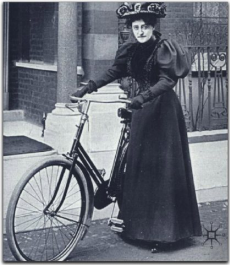
Before you start reading this very interesting article, you might want to check out my piece on the “fin de siècle”. The concept/idea of the “new woman” was something that really prevailed at the turn of the 19th Century, in the period up to the First World War. The “new woman” is related massively to the concept of feminism, which was really beginning to kick off in this era. Women began to campaign for the vote, and were becoming more and more confident out and about in the streets.
Like feminism, though, the “new woman” was not just one idea. Let’s start by having a look at what the media thought she was, as newspapers and magazines are often the first port of call for historians trying to get a feel for the past. The newspapers, and magazines like Punch (a political, yet comedic, magazine that was very popular), showed the “new woman” as something brash and unappealing. Often, she would resemble a teenage boy rather than a woman. She would be very manly, very opinionated and outspoken, and would wear trousers rather than a traditional skirt. The idea behind this is actually similar to a popular stereotype of feminists in the media today – that they are haters of men, yet are very masculine themselves.
Critics of the “new woman” thought largely the same as the media, but would give more detail to their arguments. The “new woman” was criticised on two different, and contradictory, grounds. Firstly, she was portrayed as a bit too sexual and crude – this was down to the “free love” principle that some feminists at the time advocated. On the other hand, she was also shown to be someone who was asexual, so had no interest in sex whatsoever. The opposition thought the “new woman” was a threat to traditional gender roles, and to marriage itself.
Feminists at the time were split off into two main groups. First, there were the feminists who advocated for women’s sexual freedom, and protested the double standard that men could have sex with whoever they wanted, without punishment or reprimand. Women, however, would ruin their lives if they had sex before marriage. All the feminists objected to this double standard, but whilst some thought women should be allowed to do what they like with whoever they liked, other feminists disagreed. They said that men should be reformed, and that their sexual privilege should be revoked. This type of feminism was more common, as it was less radical and better fitted in with views at the time.
As feminism at the time related to half the population, it had a very profound impact on the fin de siècle. The “new woman” might have given confidence to some, and given them the courage to go out and enjoy what the quickly developing world had to offer. Women took advantage of the movement by writing a new style of novels, and by going out and exploring the new department stores. Although feminism was held in disregard by many men, that didn’t stop enterprising men from taking advantage of women’s new-found confidence, by trying to sell them new things they probably didn’t need. Again – you can really see how little has really changed since then!
Image from: http://www.oscholars.com/Latchkey/Gallery/Gallery-Portraits.html

0 Comment:
Be the first one to comment on this article.